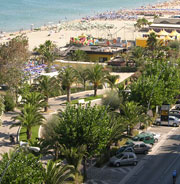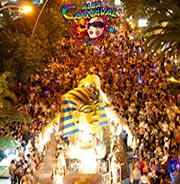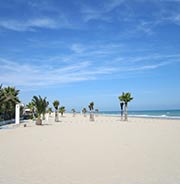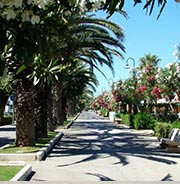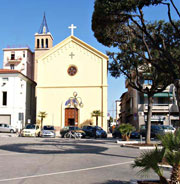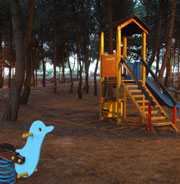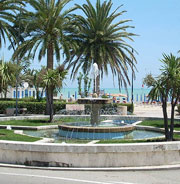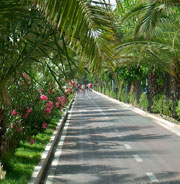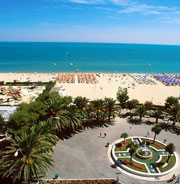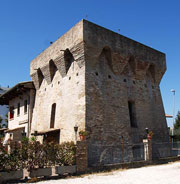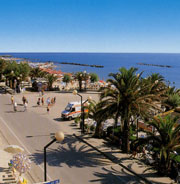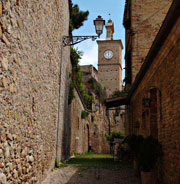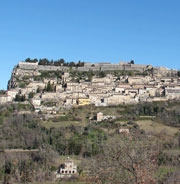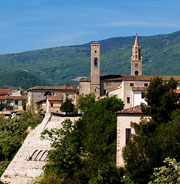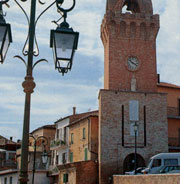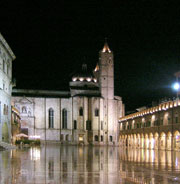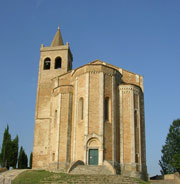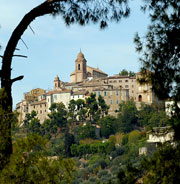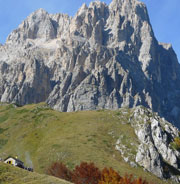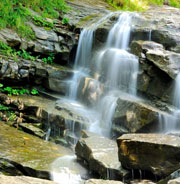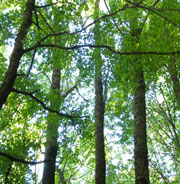| Surroundings |
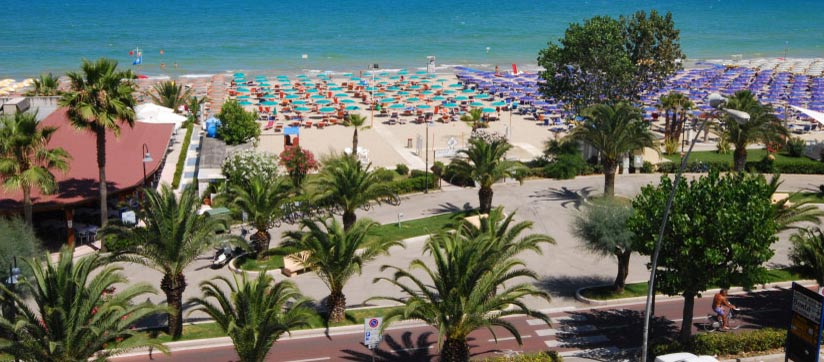
ALBA ADRIATICA (TE)
Alba Adriatica is a popular beach resort of about
10,500 inhabitants (the whole municipality) located
at the northern end of the Abruzzo region, a few kilometers
from the border with the Marches. The wide beaches (widths
up to 100 m.) Of fine sand silvery-gold, the promenade
in the green palms and pines, and the many comfortable
hotels and nightlife pose the lakeside town of Abruzzo
to the level of the most famous places along the Adriatic
coast and make it a summer destination of choice for
tens of thousands of Italian and foreign tourists. In
the center of Alba Adriatica is the ancient Tower of
Vibrata century tower built with the function of defense
of the coast.
The heart and the most lively of Alba
Adriatica is its waterfront: beautiful, long and wide.
You can take quiet walks in bike, run or skate. In fact
the whole "Riviera Blue" from Martinsicuro in Roseto
degli Abruzzi (30 km) can be traveled in peace of mind
thanks to a bike path called Green Corridor Adriatic,
completely independent of the vehicular and pedestrian
circulation, which was carried out between the roadway
and the sidewalk (waterfront).
The little ones,
certainly will want to spend many hours in the "Bambinopoli"
Municipal, an oasis of leisure and tranquility just
steps from the sea.
---------------------------------------
TRIATHLON OLIMPICO ALBA ADRIATICA - June 9, 2019
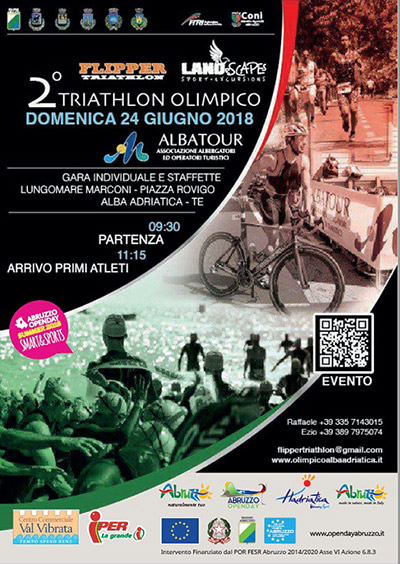
 Summer
Carnival Alba Adriatica
Summer
Carnival Alba Adriatica

the Summer Carnival of Alba Adriatica
----------------------------------------------------
Roads of Wine and
Oil
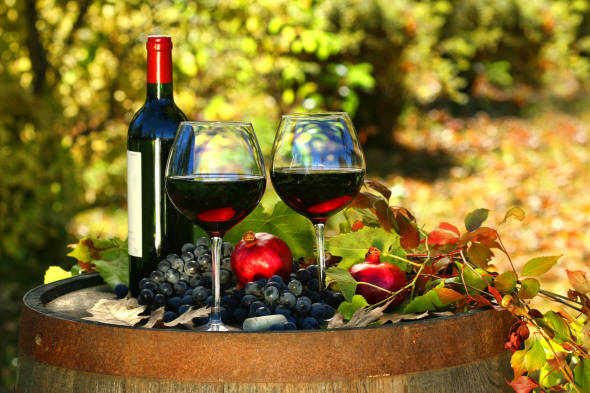
All along the coast of Teramo are countless detours
on the trail of the local. First, this is the area of
vineyards: in addition to classic Doc Montepulciano
(Montepulciano Cerasuolo) and Trebbiano d'Abruzzo, in
a small geographic area that includes the towns of Controguerra,
Torano Nuovo, Ancaster, Corropoli and Colonnella, you
grow grapes for production of the Doc "Controguerra",
both red and white. One of the Wine Roads, reported
from the region with specific signs starts from Alba
Adriatica.
Also with regard to the Oil Routes, in
the province, are two of the most famous: the one that
goes from Giulianova inward going to cross the centers
of Mosciano Sant'Angelo, Sant'Omero and Campli and the
one that climbs from Roseto degli Abruzzi to Morro d'Oro,
Notaresco and Atri.
----------------------------------
What to see around Alba
Adriatica?
MARTINSICURO
Martinsicuro (at 2.7km), the most north of the Abruzzo
coast, where you can admire the "Tower of Charles V,"
the mighty building of the sixteenth century, quadrangular
bulwark of sighting the mouth of the Tronto; Interestingly
the newsstand of the facade enclosing the heraldic insignia
of Emperor Charles V. We should also mention the Church
of the Sacred Heart of Jesus, which houses a valuable
painting apse of Joseph Pauri and "Villa Barnabei",
stately home dating back to 1866.
COLONNELLA
Along a road dotted with vineyards and orchards you
head Colonnella (6 km). Standing on top of a hill from
which you can enjoy an enchanting view. The old buildings,
squares and the plots of alleys and stairways form the
backdrop. The historic center of Colonnella, dominated
by the Church and the Civic Tower Clock, is characterized
by numerous narrow streets, called in dialect "rue".
Among the oldest buildings recall the palaces Volpi,
Marzi, Pardi and Grilli.
CIVITELLA DEL TRONTO
Civitella del Tronto, town perched on a hill at 589
m. s.l.m. and full of charm and history that overlooks
the rivers Vibrata and Salinello and offers stunning
views of the Monti della Laga, the Gran Sasso and the
Mountain of Flowers, where does the river Vibrata. Symbol
of Civitella is its fortress, stronghold of the Bourbons
before the unification of Italy, which is a real fortified
citadel; This fortress is one of the most impressive
works of military engineering in Italy; Europe is the
second largest fortress: extends for 500 meters long
and covers an area of 25,000 square meters. with very
thick walls and sloping; the town retains many medieval
and Renaissance buildings enclosed within the walls.
Civitella del Tronto is in the National Park of Gran
Sasso-Monti della Laga and the surrounding area offers
the possibility of interesting nature trails.
CAMPLI
Campli, situated on a hill between the valleys of the
rivers Fiumicino and Siccagno; rich with ancient architectural
monuments, an important necropolis of the Iron Age and
some burials, you can also admire the fourteenth century
church of St. Nicholas and St. Francis. The town, however,
is dominated by the Fortress Balascio founded around
the year one thousand.
TORTORETO
(2.9 km) is the most southerly resort on the coast.
The town of Tortoreto Alto, which with its 227 meters
above sea level is almost a "terrace" on the sea, still
guards rich evidence of the Renaissance. To visit the
historical center with towers, arches and narrow rue,
preserves the walls of a fortified medieval village,
the Clock Tower, built on an ancient stone base and
brick, belongs to the medieval period. The Church of
Mercy, preserves splendid Renaissance frescoes by Giacomo
Bonfini. The church of St. Augustine, with altars made
in the Baroque style. The Fortellezza is a natural terrace
from which you can admire the wonderful view of the
opposite coast.
ASCOLI PICENO
The city is located in the southern part of the Marche
region and is about 28 km from the Adriatic Sea and
about 35 Km from Alba Adriatica. Its urban center is
located at an altitude of 154 m above sea level, in
the area of confluence between the river and the river
Tronto Castellano, surrounded on three sides by mountains,
among which there are the mountains of Ascension, the
hill and the San Marco Mountain of Flowers. Its territory
is surrounded by two protected natural areas: the National
Park of Gran Sasso and Monti della Laga National Park
to the south and the Sibillini Mountains to the northwest.
Ascoli Piceno is one of the monumental cities of Italy,
in which there are many styles, Romanesque, Gothic,
Renaissance, Baroque ...; its historic center is built
of travertine, a sedimentary rock limestone extracted
from quarries in the area, and is centered around the
Renaissance Piazza del Popolo where some of the most
important buildings including the Palace of the Captains,
the historic Caffè Meletti and church of San Francesco.
Other core city is the urban space of square Arringo,
the oldest square in Ascoli, where rise the medieval
Baptistery of San Giovanni, the Cathedral of St. Emidio,
which encloses the crypt also dedicated to the patron
saint. There are also the Bishop's Palace, the palace
dell'Arengo, home of the civic art gallery and some
municipal offices. Not only the squares, but also the
streets and alleys of the medieval imprint genuinely
help to characterize the historic center. Among the
monuments are to remember: the Roman bridge Solestà,
one of the few in Italy, also visited the inside, the
ruins of the Roman theater, the caves of the Annunciation,
mammoth building of the Roman period, the Fortezza Pia
and the Forte Malatesta , the building with the tower
of Lombard Ercolani, one of the surviving towers between
the two hundred that appear in medieval chronicles,
for which Ascoli has the nickname City of a Hundred
Spires. Also there are many churches, cloisters, squares
and fountains to visit.
OFFIDA
Offida is a town in the province of Ascoli Piceno, which
is about 35 Km from Alba Adriatica. And 'situated in
the center of the Sub Marche, whose territory is situated
entirely in the river valleys Tesino (north) and the
river Tronto (south).
The town owes its irregular
plan to rocky outcrop on which it stands, carved out
by the two arms of springs, the torrent Lama, left tributary
of the Tronto.
Offida entered May 2, 2008 in the
club of the most beautiful villages in Italy. There
are remains of medieval walls with towers, while the
sixteenth-century fortress remain a stretch of wall
and two cylindrical towers. The historic center of Offida
is enclosed within the ancient City Wall (sec. XII),
the starting point of an ideal route through the streets
and squares of the country, a path along which there
are monuments of great historical, artistic and architectural
testimony of an illustrious past. In the main square
stands the Town Hall, an elegant building dating from
the eleventh and twelfth centuries that still represents
the heart of the administrative life of Offida.
Inside the town hall is the Teatro Golden Snake, a true
gem of Baroque conception of proscenium type or, as
commonly called, the Italian, with diagram "horseshoe".Not
far away the Collegiate Church, which houses the crypt
reconstruction of the Grotto of Lourdes; the Addolorata
Church which houses the coffin of the dead Christ and
the Church of St. Augustine, with the adjoining Chapel
of the Eucharistic Miracle The most important monument
of Offida is the church of Santa Maria della Rocca,
rebuilt in 1330 on a small church in the eleventh century.
Tourist itinerary can not be forgotten the Museum
of Offida and the 'former convent of San Francesco which
houses the Enoteca Regionale delle Marche. Offida, with
over 1,100 hectares of vineyards, is the town of the
province of Ascoli Piceno with the largest vineyard
area and one of the first of the Marche Region. In recent
years, with studies and research on varieties, production
techniques and winemaking, has achieved a quality of
the wines of great excellence that, increasingly, are
affirmed in both expert and consumer.
There are
four D.O.C. in the area: Rosso Piceno, Rosso Piceno
Superiore Falerio Hills Ascoli and Offida Doc's recent
approval. It is also typical Vino Cotto, is a very sweet
wine and liqueur that is obtained by cooking the must
not yet fermented, usually served after a meal, accompanied
to dessert.
And The Mystras, which is an artisan
liquor that is obtained by distilling wine, flavored
variously adding anise or herbs, and is an effective
digestive.
MONTEPRANDONE
Is located in the center
of the Sub Marche, located in the hinterland of San
Benedetto del Tronto, just 5 km from the Adriatic sea
and 15 from Alba Adriatica. Monteprandone, in the province
of Ascoli Piceno, stands on a hill at an altitude of
280 above sea level, which is about five kilometers
offering breathtaking views of both the sea and the
nearby mountains. And 'the home of St. James of the
Marches and the painter Carlo Allegretti.
The first
historical document concerning Monteprandone dates back
to 1039, when a certain Longinus with such Guido Massaro
made a gift of the village and the church of St. Nicholas
of Bari to the Monastery of Santa Maria di Farfa who
held it until 1300 when, spontaneously, the population
for safety reasons decided to pass under the protection
of Ascoli. The link with Ascoli then became more and
more intense over the years. The old town is typically
medieval and preserves the ancient walls (of the XIV-XV)
and alleys.
The Town Hall houses the precious library
of St. James with the "Codes Autographs" and other miniatures;
the Collegiate Church of St. Nicholas preserves a wooden
crucifix sec. XVIII. At a mile from the historic center
is the Convent of Santa Maria delle Grazie or St. James
of the Marches where inside there are works precious.
In the chapel of St. James is an elegant Renaissance
portal dated 1543.
The hills are full of vineyards
that give rise to DOC wines such as Rosso Piceno Superiore
or White Falerio of packages Ascoli. The wines are always
accompanied with delicious dishes and typical as ham,
loin, sausage, chicken livers with eggs, cheese, pappardelle
with duck suit, rabbit ('ncip-'nciap), skewers of mutton,
lamb chops.
Parco Nazionale Gran Sasso e Monti della Laga
Extended across three regions: Abruzzo, Lazio and Marche,
and five provinces: L'Aquila, Teramo, Pescara, Ascoli
Piceno and Rieti, with its nine centers, the Network
of Museums and Visitor Centers , engaged in the care
and protection of land as in the enhancement of the
anthropological, the Park is a very complex reality,
which requires management practices and governance tools
as complex and virtuous, both in terms of administrative,
political and socio-economic , both from the environmental
point of view.
